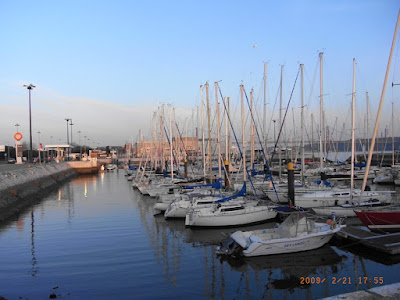
quinta-feira, 26 de fevereiro de 2009
Alfama
FROM WIKIPEDIA
Alfama (pron. IPA: [aɫ'fɐmɐ]) is the oldest district of Lisbon, spreading on the slope between the Castle of Lisbon and the Tejo river. Its name comes from the Arabic Al-hamma, meaning fountains or baths. It contains many important historical attractions, with many Fado bars and restaurants.
During the times of Moorish domination, Alfama constituted the whole of the city, which later spread to the West (Baixa neighbourhood). Alfama became inhabited by the fishermen and the poor, and its condition as the neighbourhood of the poor continues to this day. The great 1755 Lisbon Earthquake did not destroy the Alfama, which has remained a picturesque labyrinth of narrow streets and small squares.

Alfama (pron. IPA: [aɫ'fɐmɐ]) is the oldest district of Lisbon, spreading on the slope between the Castle of Lisbon and the Tejo river. Its name comes from the Arabic Al-hamma, meaning fountains or baths. It contains many important historical attractions, with many Fado bars and restaurants.
During the times of Moorish domination, Alfama constituted the whole of the city, which later spread to the West (Baixa neighbourhood). Alfama became inhabited by the fishermen and the poor, and its condition as the neighbourhood of the poor continues to this day. The great 1755 Lisbon Earthquake did not destroy the Alfama, which has remained a picturesque labyrinth of narrow streets and small squares.

Alfama
From Wikipedia
Alfama (pron. IPA: [aɫ'fɐmɐ]) is the oldest district of Lisbon, spreading on the slope between the Castle of Lisbon and the Tejo river. Its name comes from the Arabic Al-hamma, meaning fountains or baths. It contains many important historical attractions, with many Fado bars and restaurants.
During the times of Moorish domination, Alfama constituted the whole of the city, which later spread to the West (Baixa neighbourhood). Alfama became inhabited by the fishermen and the poor, and its condition as the neighbourhood of the poor continues to this day. The great 1755 Lisbon Earthquake did not destroy the Alfama, which has remained a picturesque labyrinth of narrow streets and small squares.

Alfama (pron. IPA: [aɫ'fɐmɐ]) is the oldest district of Lisbon, spreading on the slope between the Castle of Lisbon and the Tejo river. Its name comes from the Arabic Al-hamma, meaning fountains or baths. It contains many important historical attractions, with many Fado bars and restaurants.
During the times of Moorish domination, Alfama constituted the whole of the city, which later spread to the West (Baixa neighbourhood). Alfama became inhabited by the fishermen and the poor, and its condition as the neighbourhood of the poor continues to this day. The great 1755 Lisbon Earthquake did not destroy the Alfama, which has remained a picturesque labyrinth of narrow streets and small squares.

domingo, 22 de fevereiro de 2009
Preparing to return home. Bus, Belem
Discoveries monument
Monument to the Discoveries) is a monument that celebrates the Portuguese who took part in the Age of Discovery of the 15th and 16th centuries. It is located on the estuary of the Tagus river in the Belém parish of Lisbon, Portugal, where ships departed to their often unknown destinations.
The monument consists of a 52 metre-high slab of concrete, carved into the shape of the prow of a ship. The side that faces away from the river features a carved sword stretching the full height of the monument. It was conceived by Portuguese artists, architect Cottinelli Telmo and sculptor Leopoldo de Almeida as a temporary beacon of the Portuguese World Fair in 1940. The Monument to the Discoveries represents a romantic idealisation of the Portuguese past that was typical during the regime of dictator Salazar.

CARAVEL

The monument consists of a 52 metre-high slab of concrete, carved into the shape of the prow of a ship. The side that faces away from the river features a carved sword stretching the full height of the monument. It was conceived by Portuguese artists, architect Cottinelli Telmo and sculptor Leopoldo de Almeida as a temporary beacon of the Portuguese World Fair in 1940. The Monument to the Discoveries represents a romantic idealisation of the Portuguese past that was typical during the regime of dictator Salazar.

CARAVEL

Monument to the Discoveries
sábado, 21 de fevereiro de 2009
sexta-feira, 20 de fevereiro de 2009
quinta-feira, 12 de fevereiro de 2009
Subscrever:
Comentários (Atom)













































